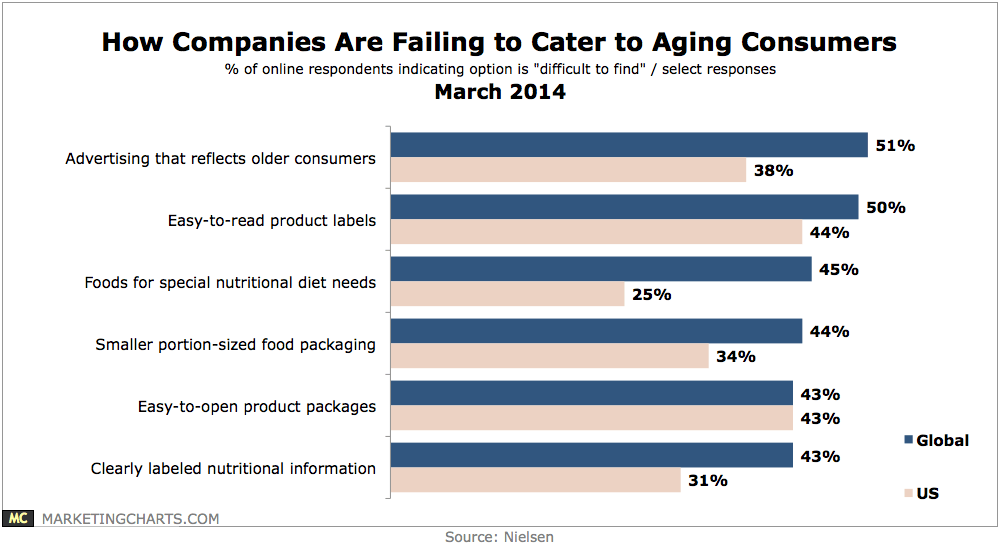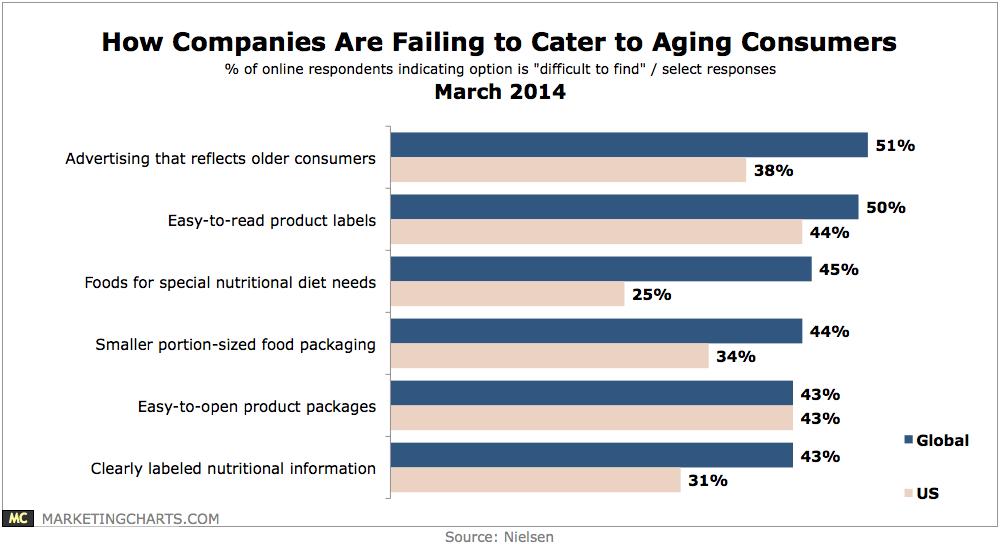
Research: Digital Signage Tuned To Boomers, And Their Parents
March 4, 2014 by Dave Haynes

A new report from market research giant Nielsen should be a good reminder to brand marketers that one of their biggest, and in many cases most affluent audiences, needs some help getting and absorbing messages.
While it’s funny to hear stories about grandmothers in their 80s struggling with Skype cameras and the UIs of smartphones, it’s not so funny to read how Baby Boomers in their 50s and 60s can’t read labels and are starting to have issues with consumer products, services and messaging that marketers might otherwise think they have nailed.
“These findings serve as a wake-up call to manufacturers, retailers and other marketers that need to bolster efforts to better reach and cater to an aging demographic,” said Todd Hale, senior vice president, Consumer & Shopper Insights, Nielsen. “People 65 and older already outnumber kids under 14 in many developed countries like Japan, Germany and Italy. While the global aging population is growing in number, their spending power is growing, too, as many have more time to shop and spend than their younger counterparts.”
Nielsen information also shows that one in three global respondents believe stores are not catering to the needs of older consumers by providing aisles dedicated to aging-needs products (34%), offering handicapped check-out lanes (33%) or lending assistance with grocery bags (36%). Roughly one in four respondents around the world say retailers are not equipped with benches to sit down (29%), ample handicapped parking (25%), handicapped bathrooms (23%), easy-to-reach shelving (23%) or handicapped ramps and doors (22%).
Needs vary a little by region, and a lot of them have little or nothing to do with retail messaging (like handicapped washrooms and wider aisles). But some do.
“As retailers and manufacturers clamor to create a point of differentiation for their products and services, they only need to listen to the loud call for help coming from aging consumers in all parts of the world,” said Hale. “Improvements such as using larger fonts on product labels and signage, arranging age-related products in one place and at arm’s length for easier accessibility, and offering friendly customer service can go a long way in building loyal patronage.”
Contrary to what may be the conventional wisdom, seniors are very interested in engaging digitally with retail.
More than one-third (37%) of global respondents say they are already ordering groceries online for home delivery, with more than half (54%) willing to try if it becomes available.
Usage of online coupons for grocery shopping is already a practice among one-third (32%) of global respondents, with percentages in Asia-Pacific (41%) and North America (38%) exceeding the global average. Three-quarters of respondents in Latin America, 64 percent in Middle East/Africa, 61 percent in Europe, and 54 percent in both Asia-Pacific and North America say they are willing to use online coupons for grocery shopping.
Online and mobile shopping lists are also used by nearly one-quarter (23%) of global respondents, while three in four respondents in Latin America are willing to use online shopping lists if they become available, along with six in 10 from Middle East/Africa (63%), Asia-Pacific (62%), North America (62%) and Europe (61%).
”While the findings are based on online respondents and represent an increased propensity for online usage, the research reflects the sentiment of leading-indicator attitudes that will only continue as Internet penetration rates grow,” said Hale. “As the Internet’s influence continues to permeate the everyday lives of connected people everywhere, savvy marketers need to ensure they are connecting with them, too.”
Yes, the 15-30 crowd can play Mass Effect 3 while texting friends and doing math homework, but people 50 and up are struggling with their eyeglass prescriptions and aren’t so good at listening to three people talk at once. However, that Boomer crowd has a lot of discretionary income and buys a lot of stuff, and may be the core clientele of a retailer, not a multi-tasking 19-year-old.
In the context of digital signage messaging, that means getting the fonts clean and large enough to read easily, slowing down the cycle of messages on a screen and limiting the amount of information conveyed in a short time spell. Ironically, it’s a best practise for most content design.
Respect your elders and they’ll “get” what you have to say ;-]



Leave a comment